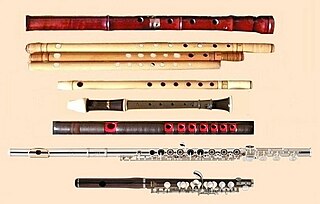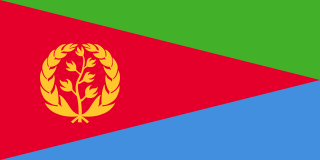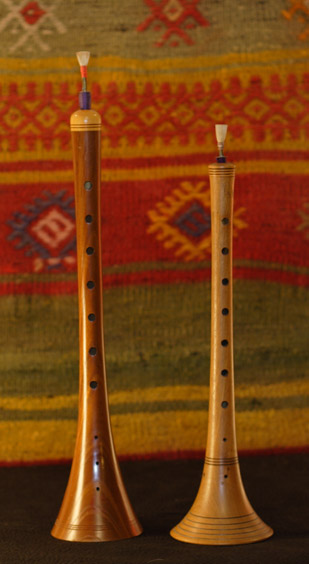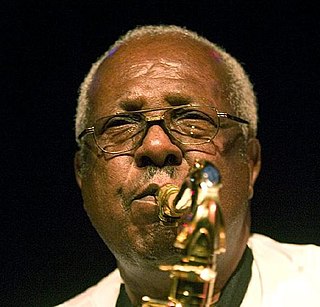Related Research Articles

The flute is a member of a family of musical instruments in the woodwind group. Like all woodwinds, flutes are aerophones, producing sound with a vibrating column of air. Flutes produce sound when the player's air flows across an opening. In the Hornbostel–Sachs classification system, flutes are edge-blown aerophones. A musician who plays the flute is called a flautist or flutist.

The lyre is a stringed musical instrument that is classified by Hornbostel–Sachs as a member of the lute family of instruments. In organology, a lyre is considered a yoke lute, since it is a lute in which the strings are attached to a yoke that lies in the same plane as the sound table, and consists of two arms and a crossbar.

Krar is a five-or-six stringed bowl-shaped lyre from Ethiopia and Eritrea. It is tuned to a pentatonic scale. A modern Krar may be amplified, much in the same way as an electric guitar or violin. The Krar, along with Masenqo and the Washint, is one of the most widespread musical instruments in Northern Ethiopia and Eritrea.

The ney, is an end-blown flute that figures prominently in traditional Persian, Turkish, Jewish, Arab, and Egyptian music. In some of these musical traditions, it is the only wind instrument used. The ney has been played for over 4,500 years, dating back to ancient Egypt, making it one of the oldest musical instruments still in use.
Ethiopian music is a term that can mean any music of Ethiopian origin, however, often it is applied to a genre, a distinct modal system that is pentatonic, with characteristically long intervals between some notes.
Music has been an integral part of Egyptian culture since antiquity in Egypt. Egyptian music had a significant impact on the development of ancient Greek music, and via the Greeks it was important to early European music well into the Middle Ages. Due to the thousands of-years long dominance of Egypt over its neighbors, Egyptian culture, including music and musical instruments, was very influential in the surrounding regions; for instance, the instruments claimed in the Bible to have been played by the ancient Hebrews are all Egyptian instruments as established by Egyptian archaeology. Egyptian modern music is considered as a main core of Middle Eastern and Oriental music as it has a huge influence on the region due to the popularity and huge influence of Egyptian cinema and music industries, owing to the political influence Egypt has on its neighboring countries, as well as Egypt producing the most accomplished musicians and composers in the region, especially in the 20th century, many of them are of international stature. The tonal structure music in the East is defined by the maqamat, loosely similar to the Western modes, while the rhythm in the East is governed by the iqa'at, standard rhythmic modes formed by combinations of accented and unaccented beats and rests.

The end-blown flute is a woodwind instrument played by directing an airstream against the sharp edge of the upper end of a tube. Unlike a recorder or tin whistle, there is not a ducted flue voicing, also known as a fipple. Most rim-blown flutes are "oblique" flutes, being played at an angle to the body's vertical axis. A notched flute is an end-blown flute with a notch on the blowing surface. A lip-valley flute is a type of notched flute.

The music of Eritrea, is a diverse mix of traditional and popular styles originating from ancient to modern times. The nine major ethnic groups of Eritrea—Afar, Bilen, Hedareb, Kunama, Nara, Rashaida, Saho, Tigre and Tigrinya—celebrate autonomous music-making expressed through a rich heritage of vocalists, instrumentalists and activities within the country and throughout the international diaspora. The country's music is informed by a range of ethnolinguistic group dynamics in the region, by its shared pre-colonial history with and revolutionized independence from Ethiopia, and by its exposure to globalized American music in the mid-twentieth century.
The various nations of the region include the Arabic-speaking countries of the Middle East, the Iranian traditions of Persia, the Jewish music of Israel and the diaspora, Armenian music. Azeri Music, the varied traditions of Cypriot music, the Turkish music of Turkey, traditional Assyrian music, Coptic ritual music in Egypt as well as other genres of Egyptian music in general. It is widely regarded that some Middle-Eastern musical styles have influenced Central Asia, as well as the Balkans and Spain.

The culture of Ethiopia is diverse and generally structured along ethnolinguistic lines. The country's Afro-Asiatic-speaking majority adhere to an amalgamation of traditions that were developed independently and through interaction with neighboring and far away civilizations, including other parts of Northeast Africa, the Arabian Peninsula, India, and Italy. By contrast, the nation's Nilotic communities and other ethnolinguistic minorities tend to practice customs more closely linked with South Sudan or the African Great Lakes region.

Turkish folk music is the traditional music of Turkish people living in Turkey influenced by the cultures of Anatolia and former territories in Europe and Asia. Its unique structure includes regional differences under one umbrella. It includes popular music from the Ottoman Empire era. After the foundation of the Turkish Republic in 1923, Turkish President Mustafa Kemal Atatürk ordered a wide-scale classification and archiving of samples of Turkish folk music from around the country, which, from 1924 to 1953 collected more than 10,000 folk songs. Traditional folk music was combined with Western harmony and musical notation to create a more modern style of popular Turkish music.

The masenqo (Amharic: ማሲንቆ; Tigrinya: ጭራ-ዋጣ, also known as masinko, is a single-stringed bowed lute commonly found in the musical traditions of Eritrea and Ethiopia. As with the krar, this instrument is used by Ethiopian minstrels called azmaris . Although it functions in a purely accompaniment capacity in songs, the masenqo requires considerable virtuosity, as azmaris accompany themselves while singing.
Orchestra Ethiopia was an Ethiopian concert band formed in 1963 by the Egyptian-born American composer and ethnomusicologist Halim El-Dabh. The group, which was founded in Addis Ababa, comprised up to 30 traditional instrumentalists, vocalists, and dancers from many different Ethiopian regions and ethnic groups. It was the first ensemble of its type, as these diverse instruments and ethnic groups previously had never played together. For a time, due to El-Dabh's efforts, the Orchestra was in residence at the Creative Arts Centre of Haile Selassie I University.
Cynthia Tse Kimberlin is an American ethnomusicologist. She is the executive director and publisher of the Music Research Institute and MRI Press, based in Point Richmond, California. Her primary area of expertise is the music of Africa, in particular Ethiopia and Eritrea.
Ashenafi Kebede was an Ethiopian composer, conductor, ethnomusicologist, historical musicologist, music educator, novelist, and poet.

An Azmari is an entertainer who sings and plays traditional string instruments of the Ethiopian Highlands. They are comparable to medieval European minstrels, bards or West African griots.
The Turkish ney is an end-blown flute made of reed, an Ottoman variation on the ancient ney. Together with the Turkish tanbur lute and Turkish kemençe fiddle are considered the most typical instruments of Classical Turkish music. The ney also plays a primary role in the music of the Mevlevi Sufi rites (semâ).

Getatchew Mekurya was an Ethiopian jazz saxophonist.
Music and politics have been closely intertwined throughout the history of Ethiopia.

The garaya or komo is an oval-bodied, two-string spike lute from Niger and Northern Nigeria.
References
- ↑ Nidel, Richard (2005). World Music: The Basics . Routlidge Taylor & Francis Group, NY.
- ↑ May, Elizabeth (1983). Musics of many cultures : an introduction. Berkeley: University of California Press. p. 239. OCLC 10960729.
- ↑ Timkehet Teffera Mekonnen (2020). "Shungul, Sorror, Washing, Woissa, Zumbara". www.academia.edu.
- ↑ Kimberlin, Cynthia Tse (1974). "Ethiopian and Tribal Music". Ethnomusicology. 18 (1): 178. doi:10.2307/850080. JSTOR 850080.
- ↑ Sárosi, B. (1967). "The Music of Ethiopian Peoples". Studia Musicologica Academiae Scientiarum Hungaricae. 9 (1/2): 14. doi:10.2307/901579. JSTOR 901579.